Analysis of Transfer Pricing in Management Accounting Report
VerifiedAdded on 2022/11/26
|19
|3315
|438
Report
AI Summary
This report delves into the realm of management accounting, specifically focusing on the application of transfer pricing within organizations. The report examines the case of Raven Industries, a company with multiple departments, and analyzes various transfer pricing methods, including market price, negotiated, and dual pricing, to determine optimal solutions for interdepartmental transfers. The executive summary highlights the importance of management accounting in formulating organizational policies and procedures for growth and development. The main body of the report explores the objectives of transfer pricing, such as performance evaluation, autonomy, and goal congruency. The report concludes that the market-based transfer pricing method is the most appropriate approach for the transferor department. Additionally, the report presents financial data, including a profit and loss account, to illustrate the impact of transfer pricing on departmental performance, and it also includes a report to the CEO explaining the benefits of transfer pricing and its effect on divisional performance measurement. The report highlights the benefits of transfer pricing for both the organization and its departments.
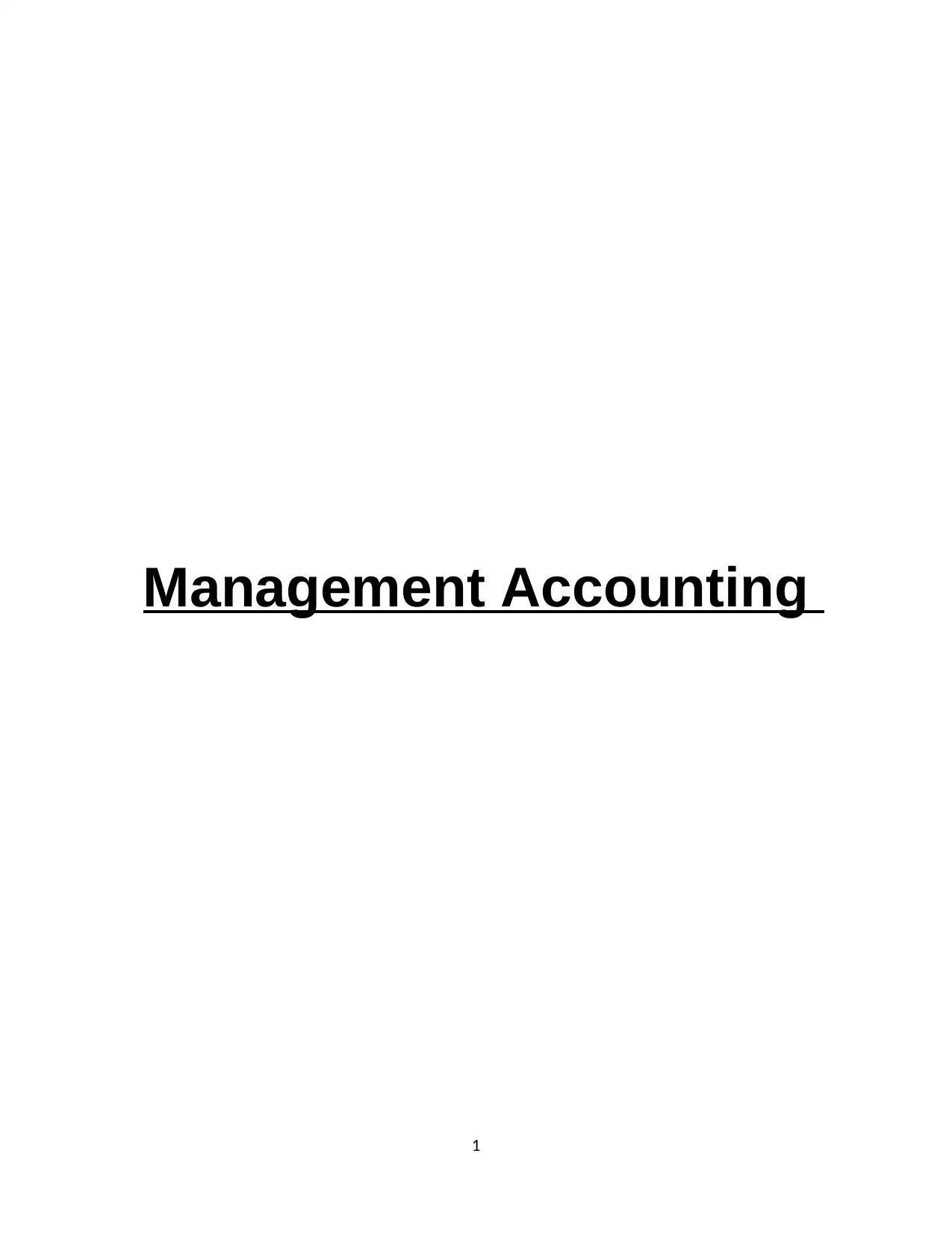
Management Accounting
1
1
Paraphrase This Document
Need a fresh take? Get an instant paraphrase of this document with our AI Paraphraser
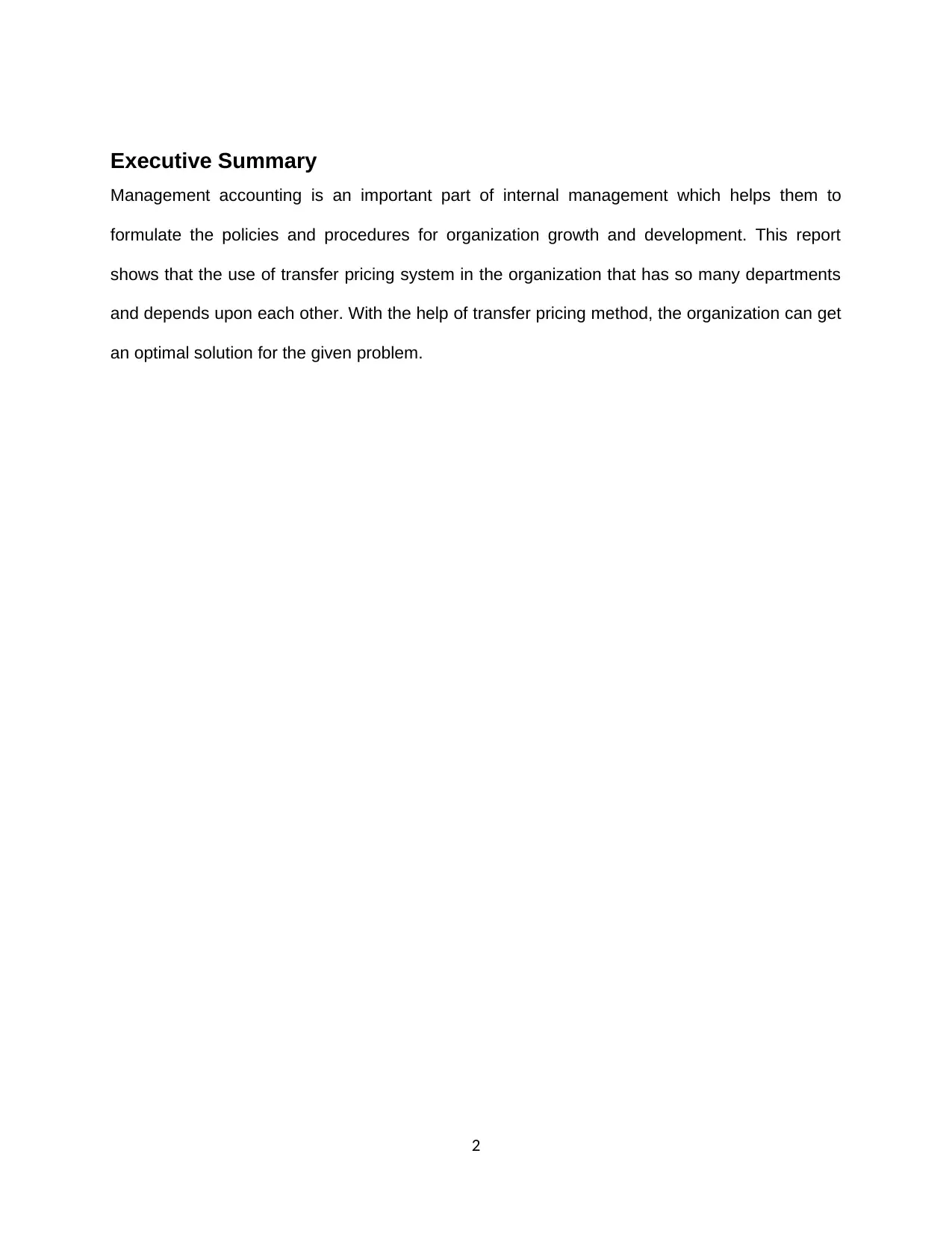
Executive Summary
Management accounting is an important part of internal management which helps them to
formulate the policies and procedures for organization growth and development. This report
shows that the use of transfer pricing system in the organization that has so many departments
and depends upon each other. With the help of transfer pricing method, the organization can get
an optimal solution for the given problem.
2
Management accounting is an important part of internal management which helps them to
formulate the policies and procedures for organization growth and development. This report
shows that the use of transfer pricing system in the organization that has so many departments
and depends upon each other. With the help of transfer pricing method, the organization can get
an optimal solution for the given problem.
2
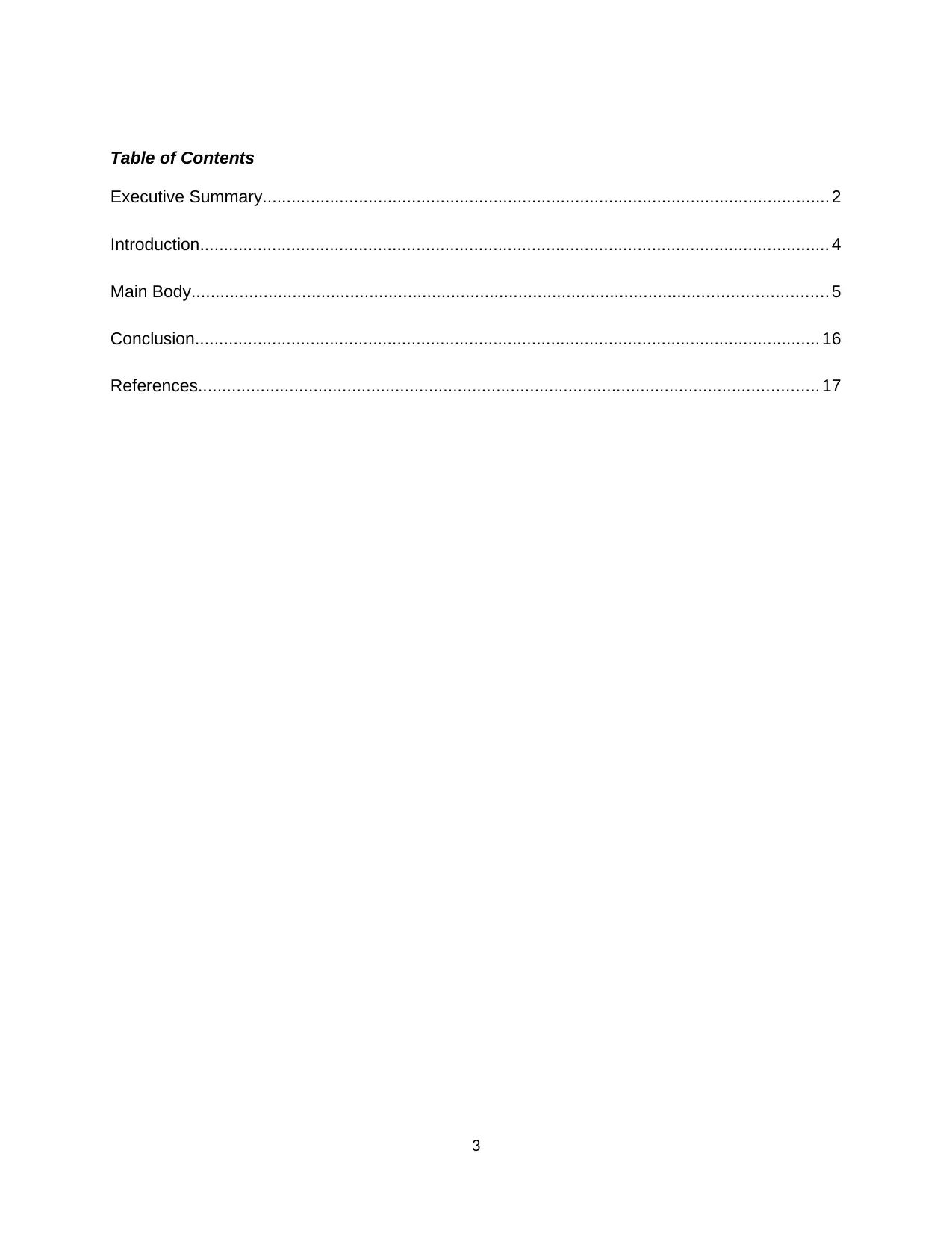
Table of Contents
Executive Summary...................................................................................................................... 2
Introduction................................................................................................................................... 4
Main Body.................................................................................................................................... 5
Conclusion.................................................................................................................................. 16
References................................................................................................................................. 17
3
Executive Summary...................................................................................................................... 2
Introduction................................................................................................................................... 4
Main Body.................................................................................................................................... 5
Conclusion.................................................................................................................................. 16
References................................................................................................................................. 17
3
⊘ This is a preview!⊘
Do you want full access?
Subscribe today to unlock all pages.

Trusted by 1+ million students worldwide
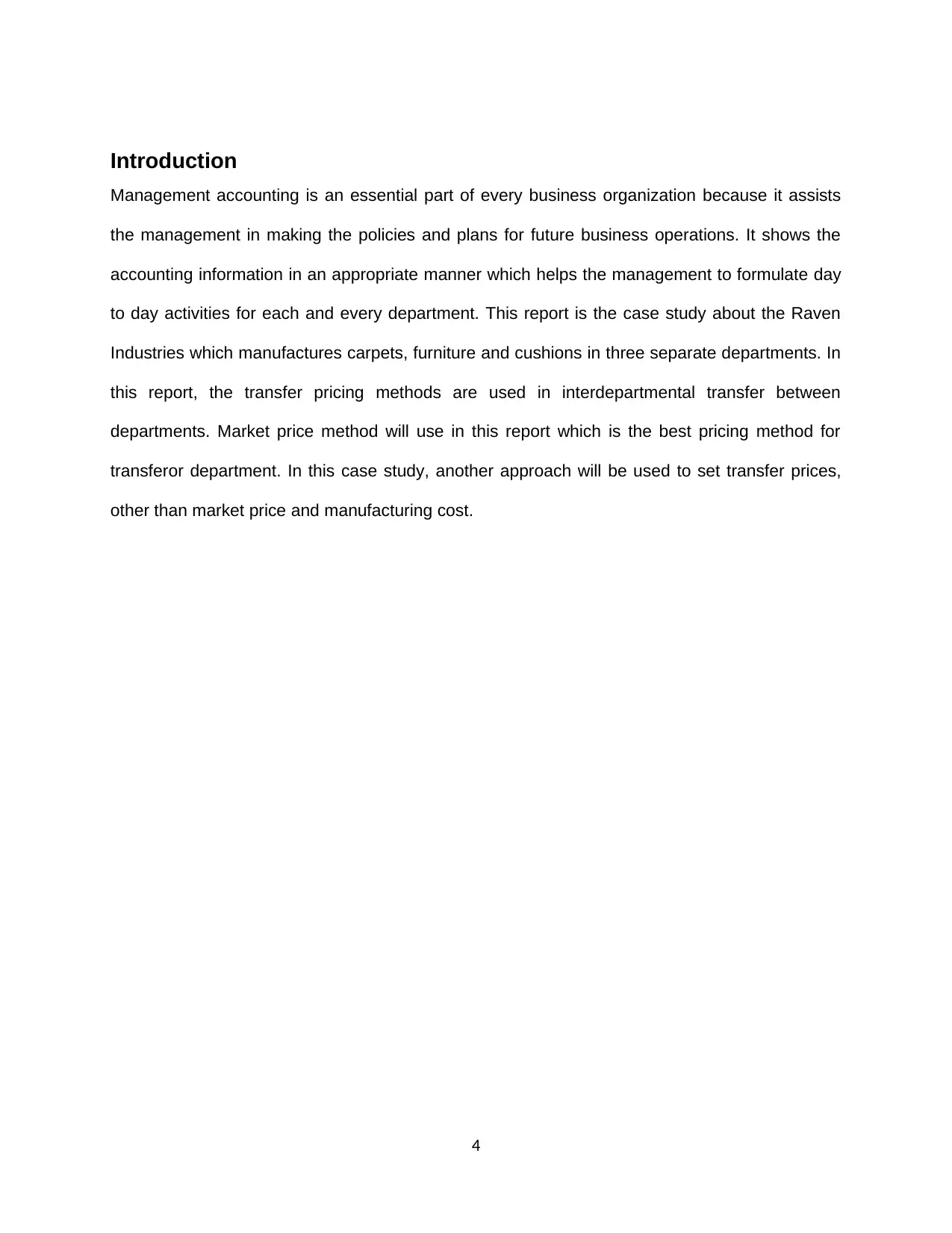
Introduction
Management accounting is an essential part of every business organization because it assists
the management in making the policies and plans for future business operations. It shows the
accounting information in an appropriate manner which helps the management to formulate day
to day activities for each and every department. This report is the case study about the Raven
Industries which manufactures carpets, furniture and cushions in three separate departments. In
this report, the transfer pricing methods are used in interdepartmental transfer between
departments. Market price method will use in this report which is the best pricing method for
transferor department. In this case study, another approach will be used to set transfer prices,
other than market price and manufacturing cost.
4
Management accounting is an essential part of every business organization because it assists
the management in making the policies and plans for future business operations. It shows the
accounting information in an appropriate manner which helps the management to formulate day
to day activities for each and every department. This report is the case study about the Raven
Industries which manufactures carpets, furniture and cushions in three separate departments. In
this report, the transfer pricing methods are used in interdepartmental transfer between
departments. Market price method will use in this report which is the best pricing method for
transferor department. In this case study, another approach will be used to set transfer prices,
other than market price and manufacturing cost.
4
Paraphrase This Document
Need a fresh take? Get an instant paraphrase of this document with our AI Paraphraser
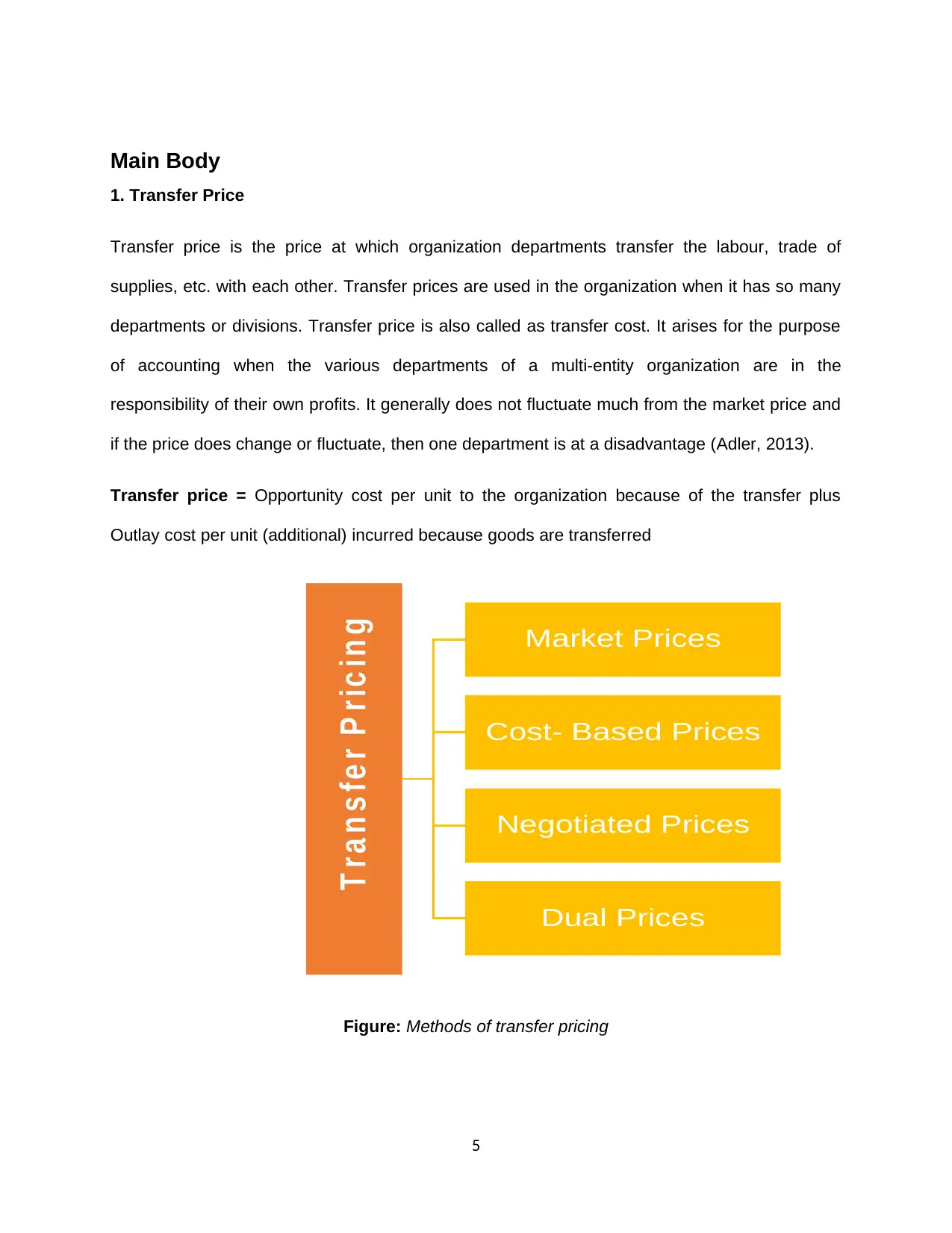
Main Body
1. Transfer Price
Transfer price is the price at which organization departments transfer the labour, trade of
supplies, etc. with each other. Transfer prices are used in the organization when it has so many
departments or divisions. Transfer price is also called as transfer cost. It arises for the purpose
of accounting when the various departments of a multi-entity organization are in the
responsibility of their own profits. It generally does not fluctuate much from the market price and
if the price does change or fluctuate, then one department is at a disadvantage (Adler, 2013).
Transfer price = Opportunity cost per unit to the organization because of the transfer plus
Outlay cost per unit (additional) incurred because goods are transferred
Figure: Methods of transfer pricing
5
T r a n s fe r P r ic in g Market Prices
Cost- Based Prices
Negotiated Prices
Dual Prices
1. Transfer Price
Transfer price is the price at which organization departments transfer the labour, trade of
supplies, etc. with each other. Transfer prices are used in the organization when it has so many
departments or divisions. Transfer price is also called as transfer cost. It arises for the purpose
of accounting when the various departments of a multi-entity organization are in the
responsibility of their own profits. It generally does not fluctuate much from the market price and
if the price does change or fluctuate, then one department is at a disadvantage (Adler, 2013).
Transfer price = Opportunity cost per unit to the organization because of the transfer plus
Outlay cost per unit (additional) incurred because goods are transferred
Figure: Methods of transfer pricing
5
T r a n s fe r P r ic in g Market Prices
Cost- Based Prices
Negotiated Prices
Dual Prices
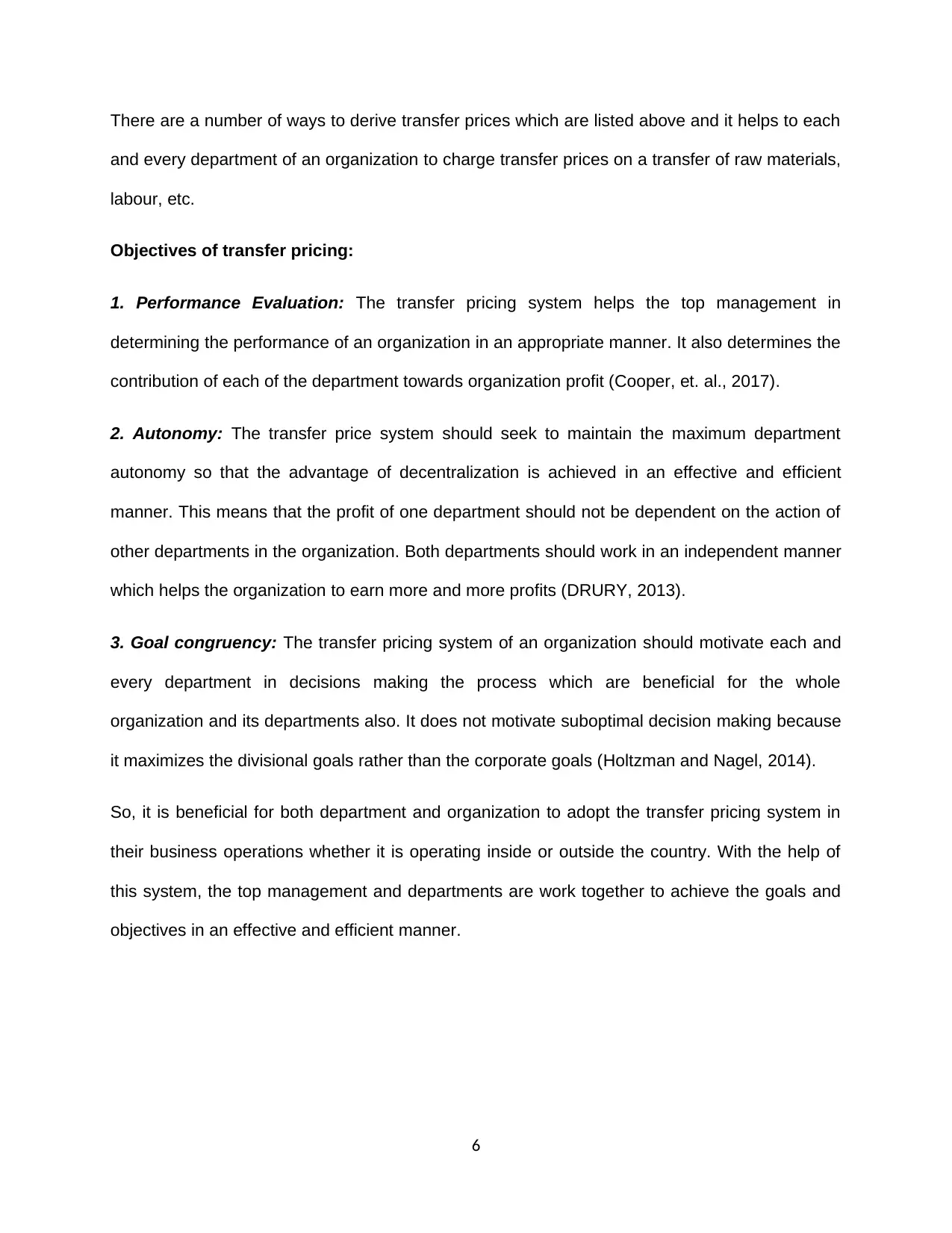
There are a number of ways to derive transfer prices which are listed above and it helps to each
and every department of an organization to charge transfer prices on a transfer of raw materials,
labour, etc.
Objectives of transfer pricing:
1. Performance Evaluation: The transfer pricing system helps the top management in
determining the performance of an organization in an appropriate manner. It also determines the
contribution of each of the department towards organization profit (Cooper, et. al., 2017).
2. Autonomy: The transfer price system should seek to maintain the maximum department
autonomy so that the advantage of decentralization is achieved in an effective and efficient
manner. This means that the profit of one department should not be dependent on the action of
other departments in the organization. Both departments should work in an independent manner
which helps the organization to earn more and more profits (DRURY, 2013).
3. Goal congruency: The transfer pricing system of an organization should motivate each and
every department in decisions making the process which are beneficial for the whole
organization and its departments also. It does not motivate suboptimal decision making because
it maximizes the divisional goals rather than the corporate goals (Holtzman and Nagel, 2014).
So, it is beneficial for both department and organization to adopt the transfer pricing system in
their business operations whether it is operating inside or outside the country. With the help of
this system, the top management and departments are work together to achieve the goals and
objectives in an effective and efficient manner.
6
and every department of an organization to charge transfer prices on a transfer of raw materials,
labour, etc.
Objectives of transfer pricing:
1. Performance Evaluation: The transfer pricing system helps the top management in
determining the performance of an organization in an appropriate manner. It also determines the
contribution of each of the department towards organization profit (Cooper, et. al., 2017).
2. Autonomy: The transfer price system should seek to maintain the maximum department
autonomy so that the advantage of decentralization is achieved in an effective and efficient
manner. This means that the profit of one department should not be dependent on the action of
other departments in the organization. Both departments should work in an independent manner
which helps the organization to earn more and more profits (DRURY, 2013).
3. Goal congruency: The transfer pricing system of an organization should motivate each and
every department in decisions making the process which are beneficial for the whole
organization and its departments also. It does not motivate suboptimal decision making because
it maximizes the divisional goals rather than the corporate goals (Holtzman and Nagel, 2014).
So, it is beneficial for both department and organization to adopt the transfer pricing system in
their business operations whether it is operating inside or outside the country. With the help of
this system, the top management and departments are work together to achieve the goals and
objectives in an effective and efficient manner.
6
⊘ This is a preview!⊘
Do you want full access?
Subscribe today to unlock all pages.

Trusted by 1+ million students worldwide
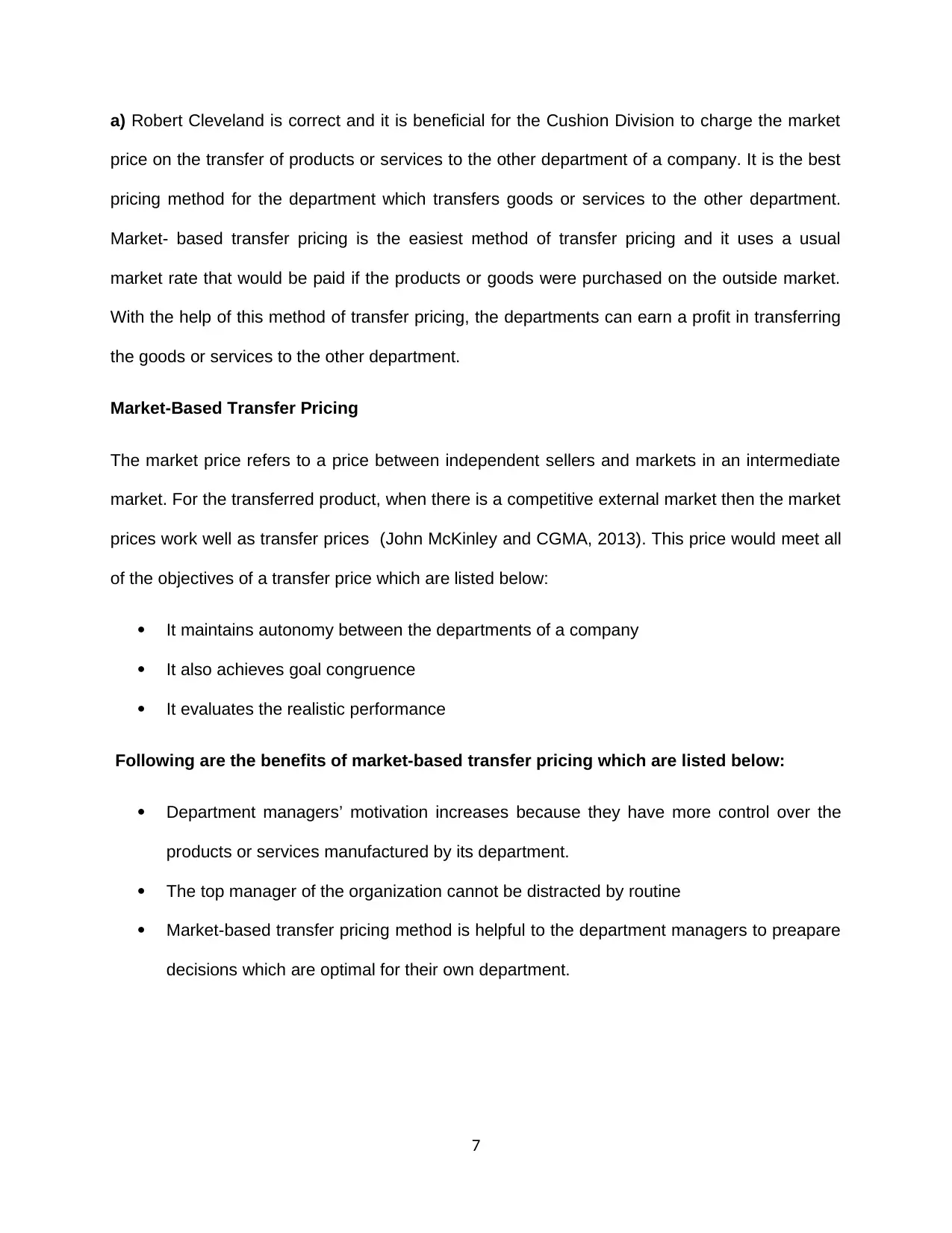
a) Robert Cleveland is correct and it is beneficial for the Cushion Division to charge the market
price on the transfer of products or services to the other department of a company. It is the best
pricing method for the department which transfers goods or services to the other department.
Market- based transfer pricing is the easiest method of transfer pricing and it uses a usual
market rate that would be paid if the products or goods were purchased on the outside market.
With the help of this method of transfer pricing, the departments can earn a profit in transferring
the goods or services to the other department.
Market-Based Transfer Pricing
The market price refers to a price between independent sellers and markets in an intermediate
market. For the transferred product, when there is a competitive external market then the market
prices work well as transfer prices (John McKinley and CGMA, 2013). This price would meet all
of the objectives of a transfer price which are listed below:
It maintains autonomy between the departments of a company
It also achieves goal congruence
It evaluates the realistic performance
Following are the benefits of market-based transfer pricing which are listed below:
Department managers’ motivation increases because they have more control over the
products or services manufactured by its department.
The top manager of the organization cannot be distracted by routine
Market-based transfer pricing method is helpful to the department managers to preapare
decisions which are optimal for their own department.
7
price on the transfer of products or services to the other department of a company. It is the best
pricing method for the department which transfers goods or services to the other department.
Market- based transfer pricing is the easiest method of transfer pricing and it uses a usual
market rate that would be paid if the products or goods were purchased on the outside market.
With the help of this method of transfer pricing, the departments can earn a profit in transferring
the goods or services to the other department.
Market-Based Transfer Pricing
The market price refers to a price between independent sellers and markets in an intermediate
market. For the transferred product, when there is a competitive external market then the market
prices work well as transfer prices (John McKinley and CGMA, 2013). This price would meet all
of the objectives of a transfer price which are listed below:
It maintains autonomy between the departments of a company
It also achieves goal congruence
It evaluates the realistic performance
Following are the benefits of market-based transfer pricing which are listed below:
Department managers’ motivation increases because they have more control over the
products or services manufactured by its department.
The top manager of the organization cannot be distracted by routine
Market-based transfer pricing method is helpful to the department managers to preapare
decisions which are optimal for their own department.
7
Paraphrase This Document
Need a fresh take? Get an instant paraphrase of this document with our AI Paraphraser
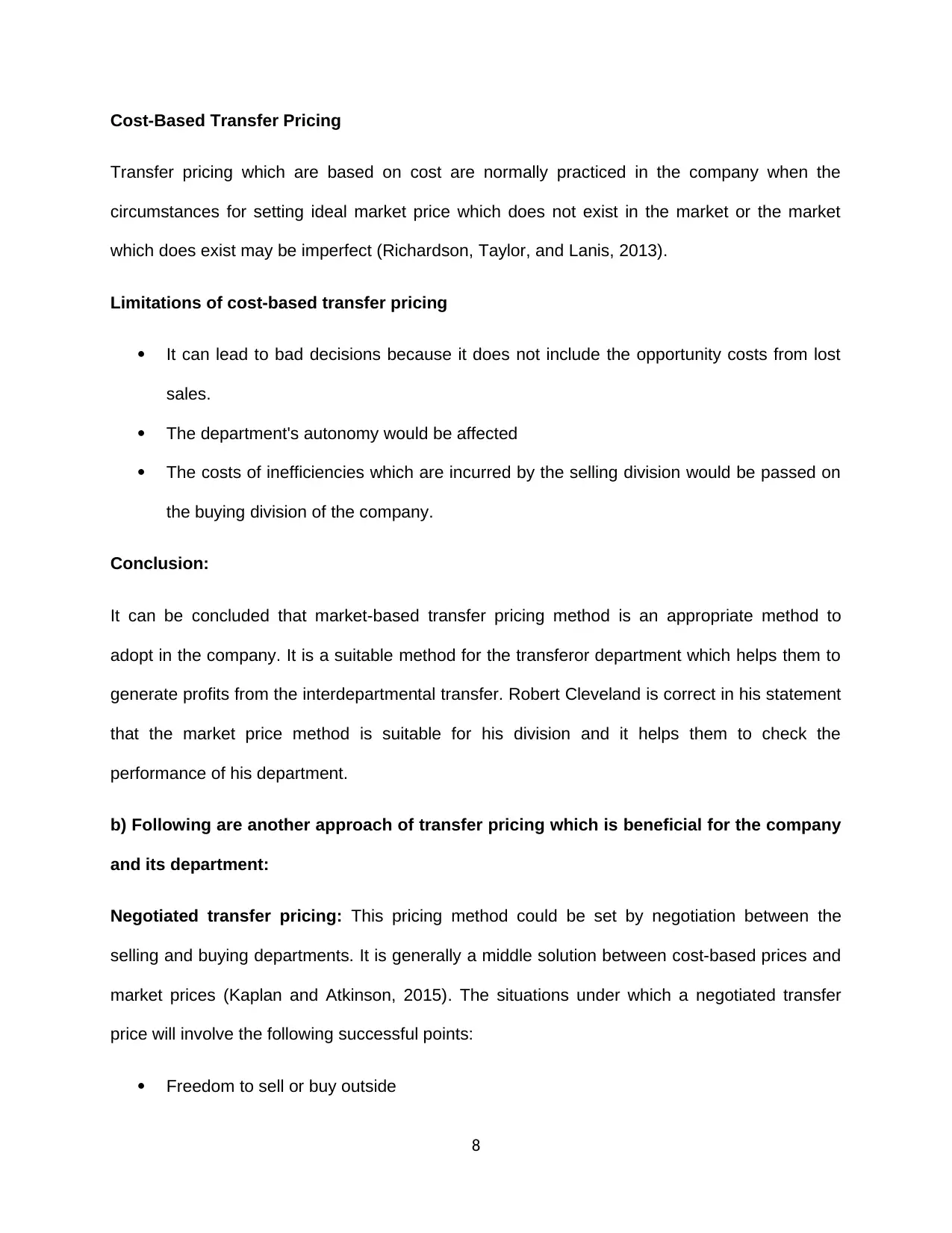
Cost-Based Transfer Pricing
Transfer pricing which are based on cost are normally practiced in the company when the
circumstances for setting ideal market price which does not exist in the market or the market
which does exist may be imperfect (Richardson, Taylor, and Lanis, 2013).
Limitations of cost-based transfer pricing
It can lead to bad decisions because it does not include the opportunity costs from lost
sales.
The department's autonomy would be affected
The costs of inefficiencies which are incurred by the selling division would be passed on
the buying division of the company.
Conclusion:
It can be concluded that market-based transfer pricing method is an appropriate method to
adopt in the company. It is a suitable method for the transferor department which helps them to
generate profits from the interdepartmental transfer. Robert Cleveland is correct in his statement
that the market price method is suitable for his division and it helps them to check the
performance of his department.
b) Following are another approach of transfer pricing which is beneficial for the company
and its department:
Negotiated transfer pricing: This pricing method could be set by negotiation between the
selling and buying departments. It is generally a middle solution between cost-based prices and
market prices (Kaplan and Atkinson, 2015). The situations under which a negotiated transfer
price will involve the following successful points:
Freedom to sell or buy outside
8
Transfer pricing which are based on cost are normally practiced in the company when the
circumstances for setting ideal market price which does not exist in the market or the market
which does exist may be imperfect (Richardson, Taylor, and Lanis, 2013).
Limitations of cost-based transfer pricing
It can lead to bad decisions because it does not include the opportunity costs from lost
sales.
The department's autonomy would be affected
The costs of inefficiencies which are incurred by the selling division would be passed on
the buying division of the company.
Conclusion:
It can be concluded that market-based transfer pricing method is an appropriate method to
adopt in the company. It is a suitable method for the transferor department which helps them to
generate profits from the interdepartmental transfer. Robert Cleveland is correct in his statement
that the market price method is suitable for his division and it helps them to check the
performance of his department.
b) Following are another approach of transfer pricing which is beneficial for the company
and its department:
Negotiated transfer pricing: This pricing method could be set by negotiation between the
selling and buying departments. It is generally a middle solution between cost-based prices and
market prices (Kaplan and Atkinson, 2015). The situations under which a negotiated transfer
price will involve the following successful points:
Freedom to sell or buy outside
8
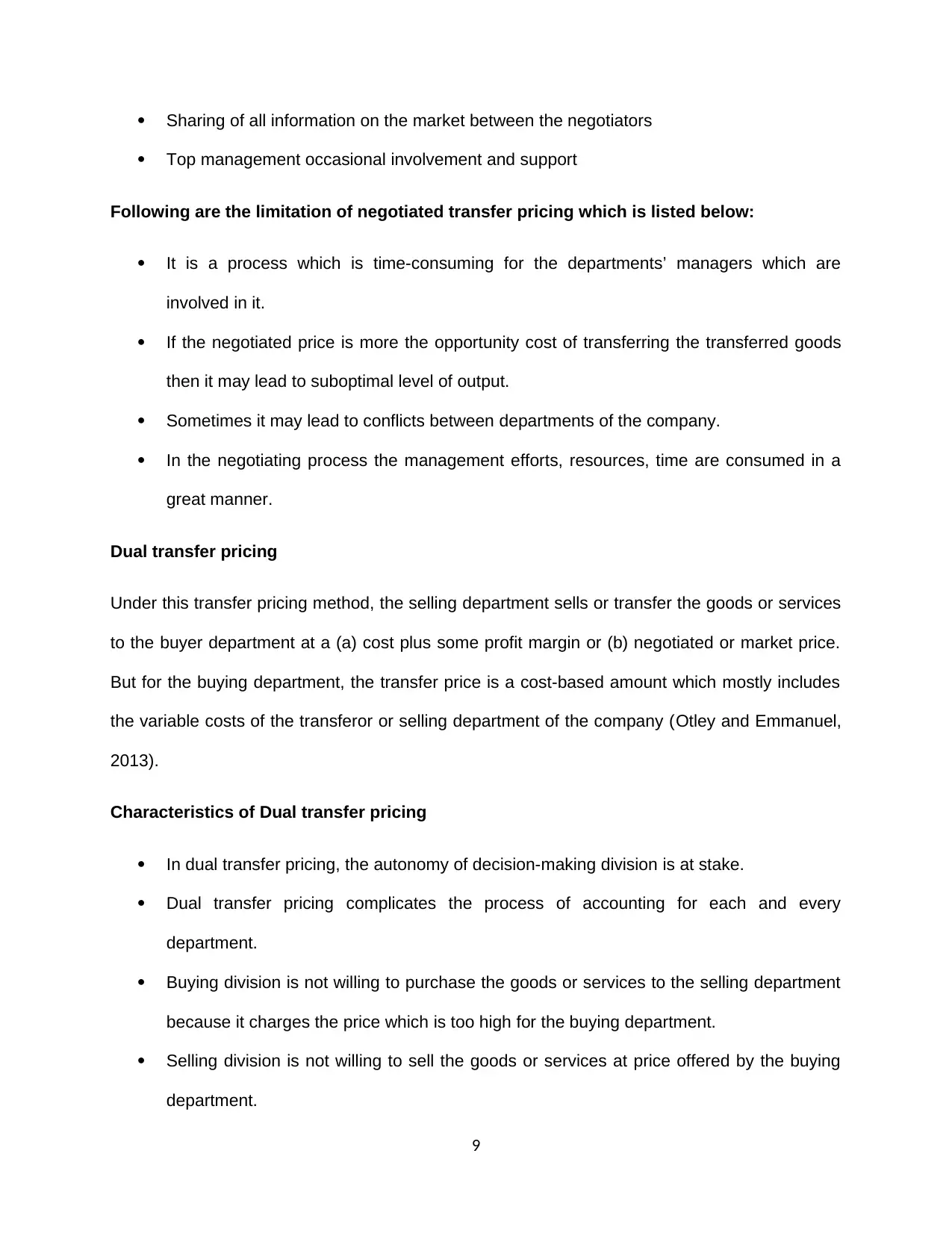
Sharing of all information on the market between the negotiators
Top management occasional involvement and support
Following are the limitation of negotiated transfer pricing which is listed below:
It is a process which is time-consuming for the departments’ managers which are
involved in it.
If the negotiated price is more the opportunity cost of transferring the transferred goods
then it may lead to suboptimal level of output.
Sometimes it may lead to conflicts between departments of the company.
In the negotiating process the management efforts, resources, time are consumed in a
great manner.
Dual transfer pricing
Under this transfer pricing method, the selling department sells or transfer the goods or services
to the buyer department at a (a) cost plus some profit margin or (b) negotiated or market price.
But for the buying department, the transfer price is a cost-based amount which mostly includes
the variable costs of the transferor or selling department of the company (Otley and Emmanuel,
2013).
Characteristics of Dual transfer pricing
In dual transfer pricing, the autonomy of decision-making division is at stake.
Dual transfer pricing complicates the process of accounting for each and every
department.
Buying division is not willing to purchase the goods or services to the selling department
because it charges the price which is too high for the buying department.
Selling division is not willing to sell the goods or services at price offered by the buying
department.
9
Top management occasional involvement and support
Following are the limitation of negotiated transfer pricing which is listed below:
It is a process which is time-consuming for the departments’ managers which are
involved in it.
If the negotiated price is more the opportunity cost of transferring the transferred goods
then it may lead to suboptimal level of output.
Sometimes it may lead to conflicts between departments of the company.
In the negotiating process the management efforts, resources, time are consumed in a
great manner.
Dual transfer pricing
Under this transfer pricing method, the selling department sells or transfer the goods or services
to the buyer department at a (a) cost plus some profit margin or (b) negotiated or market price.
But for the buying department, the transfer price is a cost-based amount which mostly includes
the variable costs of the transferor or selling department of the company (Otley and Emmanuel,
2013).
Characteristics of Dual transfer pricing
In dual transfer pricing, the autonomy of decision-making division is at stake.
Dual transfer pricing complicates the process of accounting for each and every
department.
Buying division is not willing to purchase the goods or services to the selling department
because it charges the price which is too high for the buying department.
Selling division is not willing to sell the goods or services at price offered by the buying
department.
9
⊘ This is a preview!⊘
Do you want full access?
Subscribe today to unlock all pages.

Trusted by 1+ million students worldwide
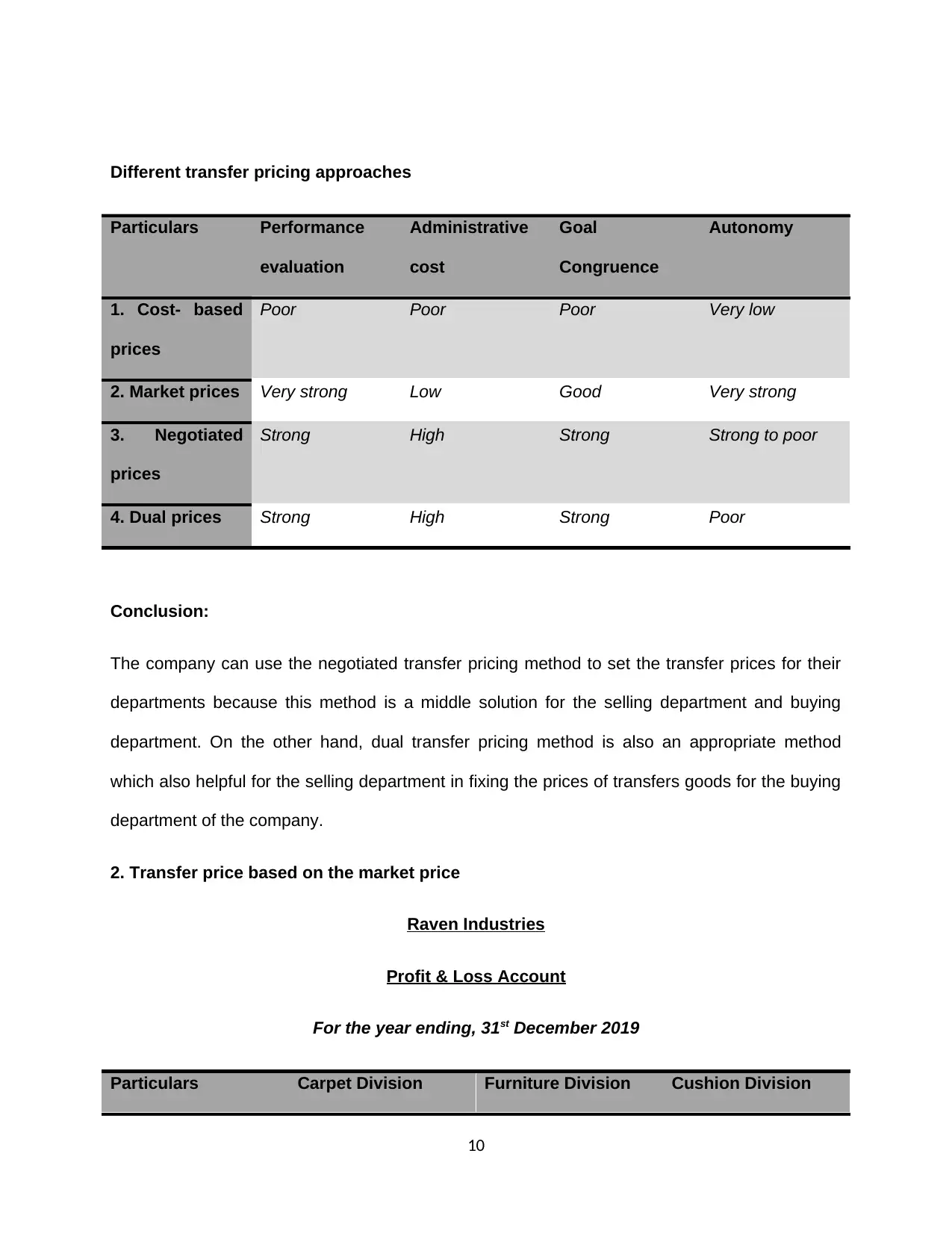
Different transfer pricing approaches
Particulars Performance
evaluation
Administrative
cost
Goal
Congruence
Autonomy
1. Cost- based
prices
Poor Poor Poor Very low
2. Market prices Very strong Low Good Very strong
3. Negotiated
prices
Strong High Strong Strong to poor
4. Dual prices Strong High Strong Poor
Conclusion:
The company can use the negotiated transfer pricing method to set the transfer prices for their
departments because this method is a middle solution for the selling department and buying
department. On the other hand, dual transfer pricing method is also an appropriate method
which also helpful for the selling department in fixing the prices of transfers goods for the buying
department of the company.
2. Transfer price based on the market price
Raven Industries
Profit & Loss Account
For the year ending, 31st December 2019
Particulars Carpet Division Furniture Division Cushion Division
10
Particulars Performance
evaluation
Administrative
cost
Goal
Congruence
Autonomy
1. Cost- based
prices
Poor Poor Poor Very low
2. Market prices Very strong Low Good Very strong
3. Negotiated
prices
Strong High Strong Strong to poor
4. Dual prices Strong High Strong Poor
Conclusion:
The company can use the negotiated transfer pricing method to set the transfer prices for their
departments because this method is a middle solution for the selling department and buying
department. On the other hand, dual transfer pricing method is also an appropriate method
which also helpful for the selling department in fixing the prices of transfers goods for the buying
department of the company.
2. Transfer price based on the market price
Raven Industries
Profit & Loss Account
For the year ending, 31st December 2019
Particulars Carpet Division Furniture Division Cushion Division
10
Paraphrase This Document
Need a fresh take? Get an instant paraphrase of this document with our AI Paraphraser
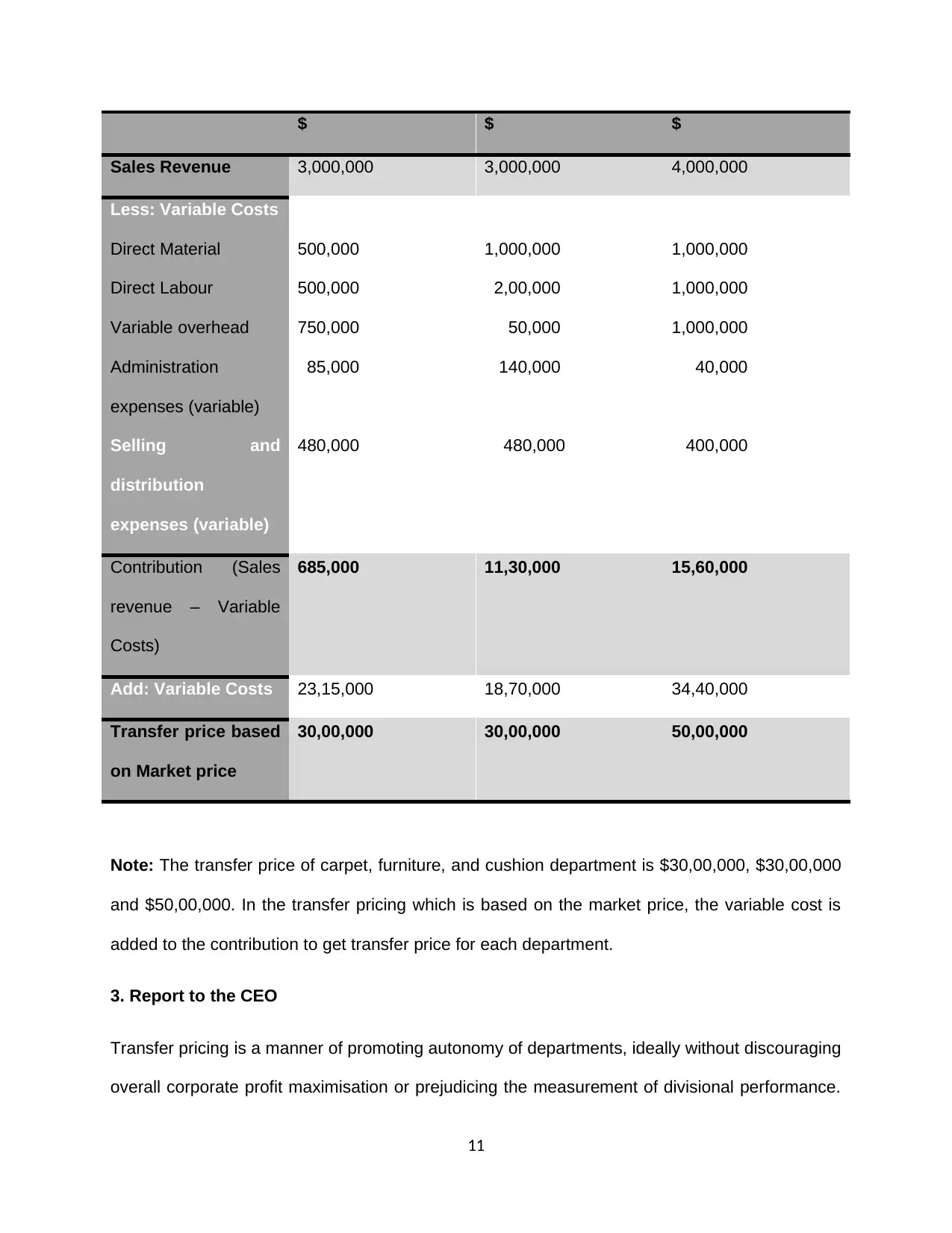
$ $ $
Sales Revenue 3,000,000 3,000,000 4,000,000
Less: Variable Costs
Direct Material
Direct Labour
Variable overhead
Administration
expenses (variable)
Selling and
distribution
expenses (variable)
500,000
500,000
750,000
85,000
480,000
1,000,000
2,00,000
50,000
140,000
480,000
1,000,000
1,000,000
1,000,000
40,000
400,000
Contribution (Sales
revenue – Variable
Costs)
685,000 11,30,000 15,60,000
Add: Variable Costs 23,15,000 18,70,000 34,40,000
Transfer price based
on Market price
30,00,000 30,00,000 50,00,000
Note: The transfer price of carpet, furniture, and cushion department is $30,00,000, $30,00,000
and $50,00,000. In the transfer pricing which is based on the market price, the variable cost is
added to the contribution to get transfer price for each department.
3. Report to the CEO
Transfer pricing is a manner of promoting autonomy of departments, ideally without discouraging
overall corporate profit maximisation or prejudicing the measurement of divisional performance.
11
Sales Revenue 3,000,000 3,000,000 4,000,000
Less: Variable Costs
Direct Material
Direct Labour
Variable overhead
Administration
expenses (variable)
Selling and
distribution
expenses (variable)
500,000
500,000
750,000
85,000
480,000
1,000,000
2,00,000
50,000
140,000
480,000
1,000,000
1,000,000
1,000,000
40,000
400,000
Contribution (Sales
revenue – Variable
Costs)
685,000 11,30,000 15,60,000
Add: Variable Costs 23,15,000 18,70,000 34,40,000
Transfer price based
on Market price
30,00,000 30,00,000 50,00,000
Note: The transfer price of carpet, furniture, and cushion department is $30,00,000, $30,00,000
and $50,00,000. In the transfer pricing which is based on the market price, the variable cost is
added to the contribution to get transfer price for each department.
3. Report to the CEO
Transfer pricing is a manner of promoting autonomy of departments, ideally without discouraging
overall corporate profit maximisation or prejudicing the measurement of divisional performance.
11
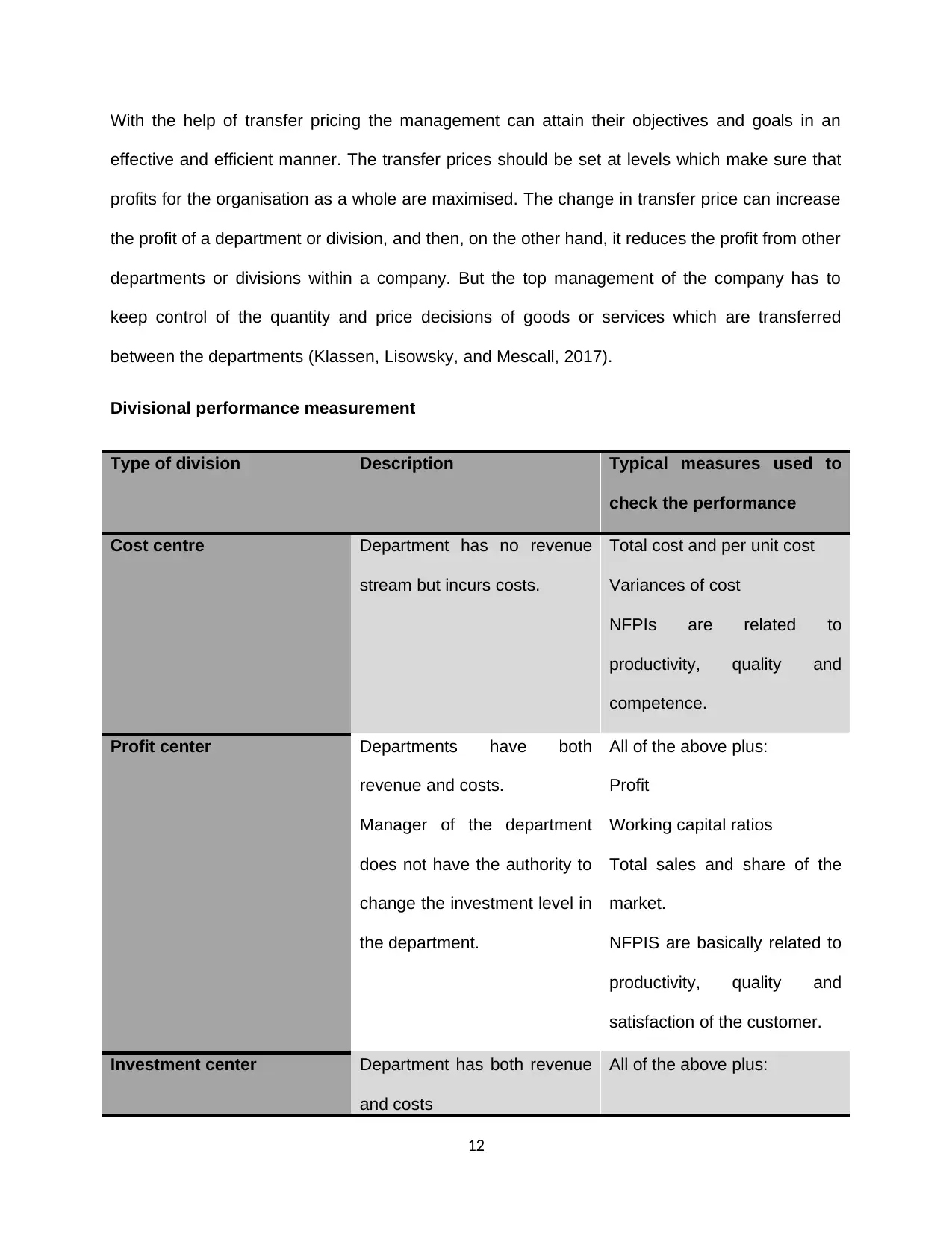
With the help of transfer pricing the management can attain their objectives and goals in an
effective and efficient manner. The transfer prices should be set at levels which make sure that
profits for the organisation as a whole are maximised. The change in transfer price can increase
the profit of a department or division, and then, on the other hand, it reduces the profit from other
departments or divisions within a company. But the top management of the company has to
keep control of the quantity and price decisions of goods or services which are transferred
between the departments (Klassen, Lisowsky, and Mescall, 2017).
Divisional performance measurement
Type of division Description Typical measures used to
check the performance
Cost centre Department has no revenue
stream but incurs costs.
Total cost and per unit cost
Variances of cost
NFPIs are related to
productivity, quality and
competence.
Profit center Departments have both
revenue and costs.
Manager of the department
does not have the authority to
change the investment level in
the department.
All of the above plus:
Profit
Working capital ratios
Total sales and share of the
market.
NFPIS are basically related to
productivity, quality and
satisfaction of the customer.
Investment center Department has both revenue
and costs
All of the above plus:
12
effective and efficient manner. The transfer prices should be set at levels which make sure that
profits for the organisation as a whole are maximised. The change in transfer price can increase
the profit of a department or division, and then, on the other hand, it reduces the profit from other
departments or divisions within a company. But the top management of the company has to
keep control of the quantity and price decisions of goods or services which are transferred
between the departments (Klassen, Lisowsky, and Mescall, 2017).
Divisional performance measurement
Type of division Description Typical measures used to
check the performance
Cost centre Department has no revenue
stream but incurs costs.
Total cost and per unit cost
Variances of cost
NFPIs are related to
productivity, quality and
competence.
Profit center Departments have both
revenue and costs.
Manager of the department
does not have the authority to
change the investment level in
the department.
All of the above plus:
Profit
Working capital ratios
Total sales and share of the
market.
NFPIS are basically related to
productivity, quality and
satisfaction of the customer.
Investment center Department has both revenue
and costs
All of the above plus:
12
⊘ This is a preview!⊘
Do you want full access?
Subscribe today to unlock all pages.

Trusted by 1+ million students worldwide
1 out of 19
Related Documents
Your All-in-One AI-Powered Toolkit for Academic Success.
+13062052269
info@desklib.com
Available 24*7 on WhatsApp / Email
![[object Object]](/_next/static/media/star-bottom.7253800d.svg)
Unlock your academic potential
Copyright © 2020–2025 A2Z Services. All Rights Reserved. Developed and managed by ZUCOL.




